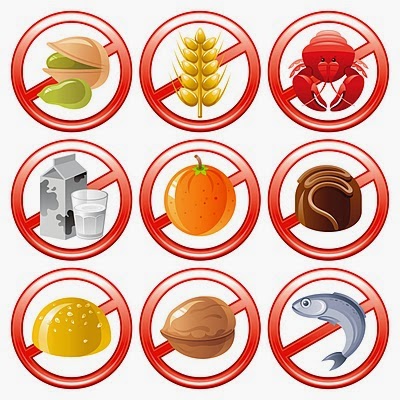When you are diagnosed with severe nickel allergy, it is important to seriously consider using a nickel-free, nickel-avoidance diet.
When I first heard the diagnosis of having a nickel allergy, I thought, "No big deal. Just avoid wearing cheap jewelry." But nickel is also found in the foods we eat and affected by the way we prepare it. YIKES!
I have been heavily doing my research to learn which foods have a high content of nickel. Every website has different foods and conflicting information. The list of items below is based upon a nickel allergy flyer my dermatologist gave me:
Severely allergic individuals may choose to avoid foods which are rich in nickel. Dietary intake of some foods has been shown to aggravate dermatitis, especially hand dermatitis. Your doctor may instruct you to avoid some foods which typically contain higher amounts of nickel, including asparagus, chocolate, peanuts, beans, peas, rhubarb, cabbage, oysters, spinach, herring, tea, mushrooms, whole meal flour, pears, sprouts, corn, raisins, onions, tomatoes, and baking powder.
Wow! Some of those items are biggies that show up frequently in my diet: chocolate, beans, cabbage, tea, onions, and tomatoes.
nonickel.com provided the following
list of foods to avoid for nickel allergy:
Grains: Whole wheat bread, multi grain breads, multi grain cereals, wheat bran, wheat germ, whole wheat pasta, oats, oatmeal, buckwheat, seeds, rye, millet

Vegetables: Beans, lentils, peas, soy products (tofu, soy sauce, soy beans) sprouts, brussel sprouts, asparagus, broccoli, cauliflower, spinach, canned vegetables, red kidney beans, chickpeas, cabbage, corn, mushrooms, onions, carrots
Fruits: Canned fruit cocktail, pears, bananas, canned fruits, tomatoes, raisins, rhubarb, dried fruit

Meats: Shellfish, herring, mackerel, tuna, processed meats with fillers or coatings, canned meats and fish

Beverages: Tea, chocolate milk, beer, red wine
OTHER SOURCES OF DIETARY NICKEL TO AVOID:
WAYS TO PREVENT YOUR BODY FROM ABSORBING THE NICKEL YOU EAT
- Chocolate and cocoa powder (especially dark chocolate)
- All nuts (walnuts, peanuts, almonds, hazelnuts, soy nuts)
- All seeds (sunflower seeds, linseed)
- Licorice
- Baking powder
- Gelatin
- Marzipan
- Margarine
- Commercial salad dressings
- Vitamins containing nickel
- Canned foods in general
- Stainless-steel cooking vessels used for cooking acidic foods
- The first quart of tap water drawn from any faucet in the morning.
- Take a vitamin C supplement with each meal.
- Eat a high iron diet
>>I'm still researching the "high iron diet". Often those types of foods are on the avoidance list. And isn't iron what I'm trying to avoid?
Penn State Hershey Dermatology published the following tips to help with nickel allergy:
Various food items and drinks can aggravate nickel dermatitis even though the nickel content of these foods may be low. These include beer,wine (in particular, red wine), herring, mackerel, tuna, tomato, onion, carrot, and certain fruits, in particular, apples and citrus fruits (juice). These vegetables can usually be tolerated when cooked.
The first liter of water taken from the tap in the morning should not be used in food preparation, as nickel may be released from the tap during the night. Nickel-plated kitchen utensils, such as egg beaters and tea balls, should be replaced.
Acid foods such as stewed fruits and rhubarb cooked in stainless steel utensils should be avoided. The acids in the foods can cause nickel to be released from the utensils. Canned foods should be eaten only in moderation.
Hand dermatitis that is affected by nickel in food will also be made worse by other conditions. Prolonged physical contact with nickel-plated items should be avoided. Other substances that can irritate sensitive skin, such as soapy water, household cleaning agents, raw fruits and vegetables, garden soil, and oil products used in repair work, should also be avoided.
Honestly, I haven't moved into the kitchen tool replacement at this point. If I do it, I will try to avoid nickel exposure in my foods, versus avoiding hand contact with tools containing nickel. It all depends on how your body is reacting with your nickel allergy. Since I am already washing my hands frequently, avoiding touching my face, and my eyes seem to react the most, touching nickel in kitchen tools is not my biggest area of concern.
Other resources:




